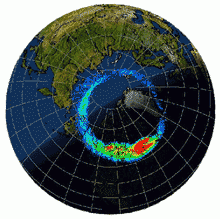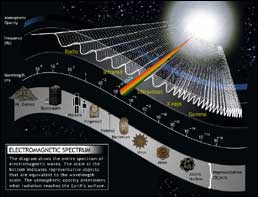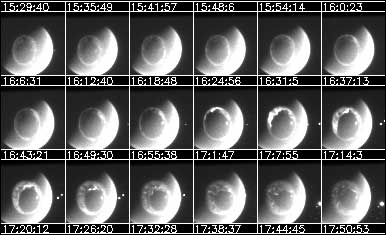History of Auroral Substorms
The concept of a global aurora that evolves in a particular way took quite some time and a lot of data to discover. During the International Geophysical Year (IGY) (1957-58), space scientists all around the world coordinated their efforts to record the aurora from many places at the same time. More than 100 All-Sky cameras were set up to watch the aurora as Earth revolved underneath it. From the analysis of this data, two important concepts in auroral physics were born: "auroral oval" and "auroral substorm."
The Auroral Oval
Using data from the IGY All-Sky cameras, a Japanese graduate student, Shun-ichi Akasofu, was one of the first to understand that the global aurora in the North was an oval of light surrounding the north magnetic pole: the auroral oval. He wrote about his personal experience discovering the auroral oval in the "Proceedings of the Second International Conference on Substorms," (1994, pg 14:)
All the IGY films were archived at the Geophysical Institute. About that time I was told that Joe Chamberlain (a well known aurora professor) had completed an authoritative book on the aurora so complete that there was nothing left to study on the aurora – bad news for a young researcher who had come all the way from Japan!
The thickness of his book discouraged me to read, so that I decided to study the aurora based on my own observations. The first thing I noticed was that the aurora tends to appear in the northern horizon in the evening and to shift southward as the night progresses. After midnight, it shifts back to the northern horizon. Of course this was a well-known fact even in those days. However, Chamberlain's book did not give any clear explanation for this well-known phenomenon.
 After looking at All-Sky camera data from several different locations around the globe that took data at the same time, Shun-ichi Akasofu realized that the aurora occurs instantaneously in ovals surrounding Earth's magnetic poles. It became clear that the aurora wasn't moving at all – only Earth was moving under a global auroral oval that was located further south at midnight than at dawn and dusk. At that same time, 1960-1963, another space scientist in Russia, Yasha Feldstein, had already published a paper with the exact same results. But it took the scientific community many years for the implications of the data and results to sink in.
After looking at All-Sky camera data from several different locations around the globe that took data at the same time, Shun-ichi Akasofu realized that the aurora occurs instantaneously in ovals surrounding Earth's magnetic poles. It became clear that the aurora wasn't moving at all – only Earth was moving under a global auroral oval that was located further south at midnight than at dawn and dusk. At that same time, 1960-1963, another space scientist in Russia, Yasha Feldstein, had already published a paper with the exact same results. But it took the scientific community many years for the implications of the data and results to sink in.
Auroral Substorms
Meanwhile, Shun-ichi Akasofu began looking more closely at the All-Sky camera data. He writes (on page 17):
 At that time, it was also firmly believed that there was a fixed pattern (with respect to the sun) of auroral activity. In the evening, the aurora had a quiet, homogenous arc form, while the aurora over the midnight sky was always very active. The morning sky was covered by patchy aurora. The Earth rotates once a day under such a fixed pattern. As a result, standing at a point on the Earth, the aurora appeared to undergo a daily variation, from a quiet homogeneous arc, to active rayed arcs and finally to patchy auroras, as the Earth's rotation carries the observer under the fixed pattern.
At that time, it was also firmly believed that there was a fixed pattern (with respect to the sun) of auroral activity. In the evening, the aurora had a quiet, homogenous arc form, while the aurora over the midnight sky was always very active. The morning sky was covered by patchy aurora. The Earth rotates once a day under such a fixed pattern. As a result, standing at a point on the Earth, the aurora appeared to undergo a daily variation, from a quiet homogeneous arc, to active rayed arcs and finally to patchy auroras, as the Earth's rotation carries the observer under the fixed pattern.
… I did not get the same impression by examining miles of All-Sky film from even a single station. For example, All-Sky photographs from Saskatoon, Canada, showed that the aurora underwent this transformation three times in a single night. This indicated to me that either the fixed pattern concept was not correct or that the Earth rotated three times on that night. The conclusion was obvious. When simultaneous All-Sky photographs from Siberia, Alaska and Canada were examined together, it was found that auroras along a significant part of the oval simultaneously undergo large-scale changes, from a quiet condition to an active condition and back to a quiet condition; such changes were repeated few times a night.
And this was the beginning of the term "auroral substorm." Shun-ichi Akasofu drew schematic illustrations to show how the auroral substorm develops using the All-Sky data and published his results in 1964. When satellites (such as ISIS2 in 1973, DMSP in 1974, Kyokko in 1981, and DE1 in 1982) were put into space to study the aurora, scientists saw exactly what Shun-ichi Akasofu had drawn from many cameras located on Earth: auroral substorms.
Since 1964, the different phases in the evolution of the substorm have been given particular names. The initial calm phase before the aurora becomes active, is called the growth phase. The time when the aurora changes from a slow moving homogeneous arc to many dancing auroral forms is called substorm onset. The rapidly moving aurora that fills the sky occurs during the breakup phase. And the time with patchy aurora that pulsates on and off is called the recovery phase. THEMIS will discover what triggers substorm onset.
Viewing Auroral Substorms from Space
 Instead of using light visible to our eyes, most of the cameras on the satellites take pictures of Earth and the aurora in a type of light our eyes cannot see: ultraviolet light. When we look at Earth in ultraviolet light, we cannot see the continents and the ocean. Instead, an instrument that looks at the ultraviolet Earth sees the gases glowing from sunlight in the upper atmosphere. Such an instrument can also see the Northern (Southern) Lights as an oval surrounding the North (South) Magnetic Pole.
Instead of using light visible to our eyes, most of the cameras on the satellites take pictures of Earth and the aurora in a type of light our eyes cannot see: ultraviolet light. When we look at Earth in ultraviolet light, we cannot see the continents and the ocean. Instead, an instrument that looks at the ultraviolet Earth sees the gases glowing from sunlight in the upper atmosphere. Such an instrument can also see the Northern (Southern) Lights as an oval surrounding the North (South) Magnetic Pole.

|



